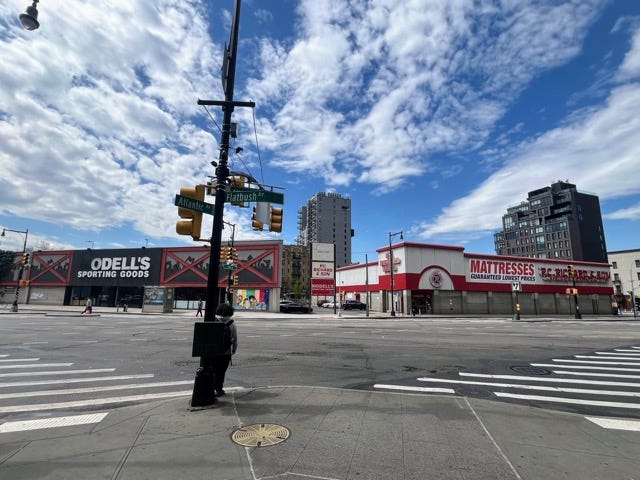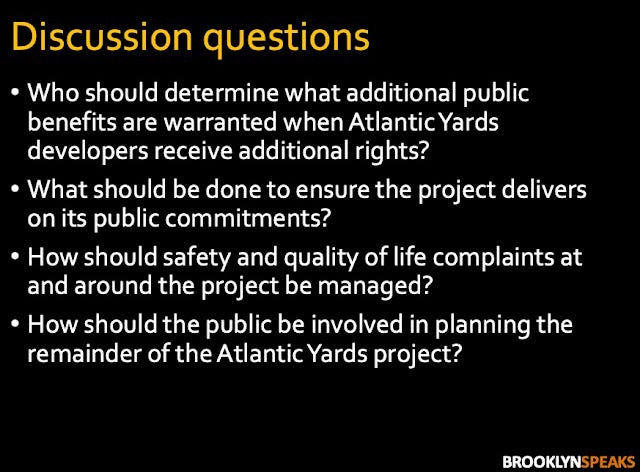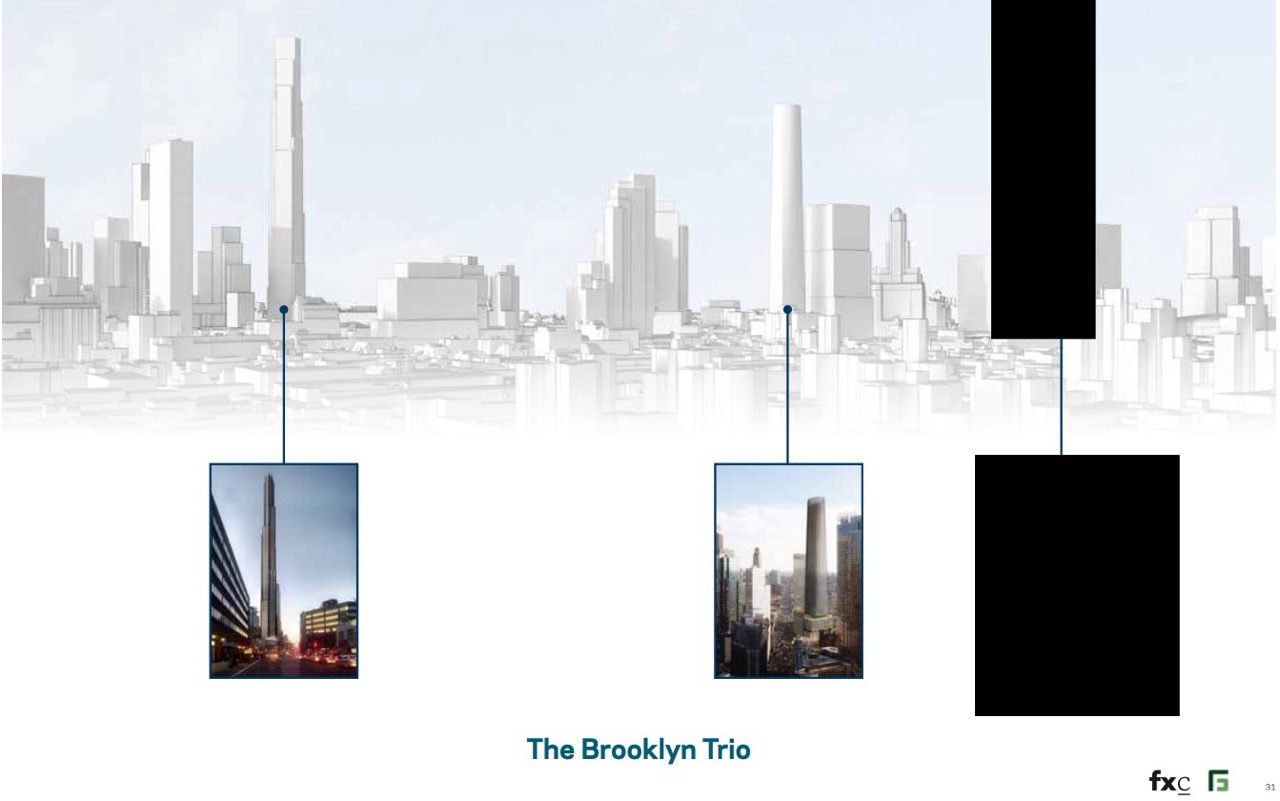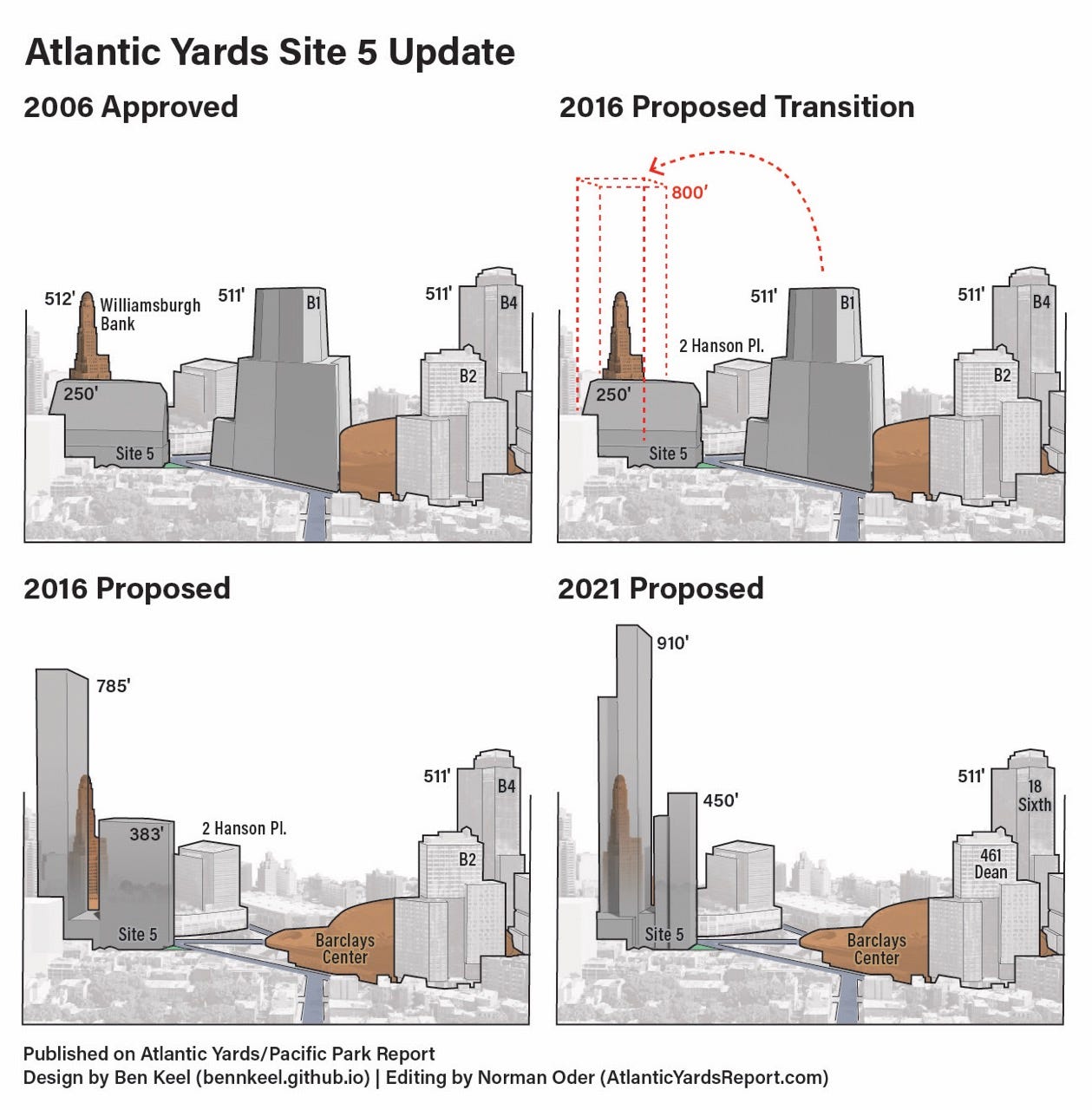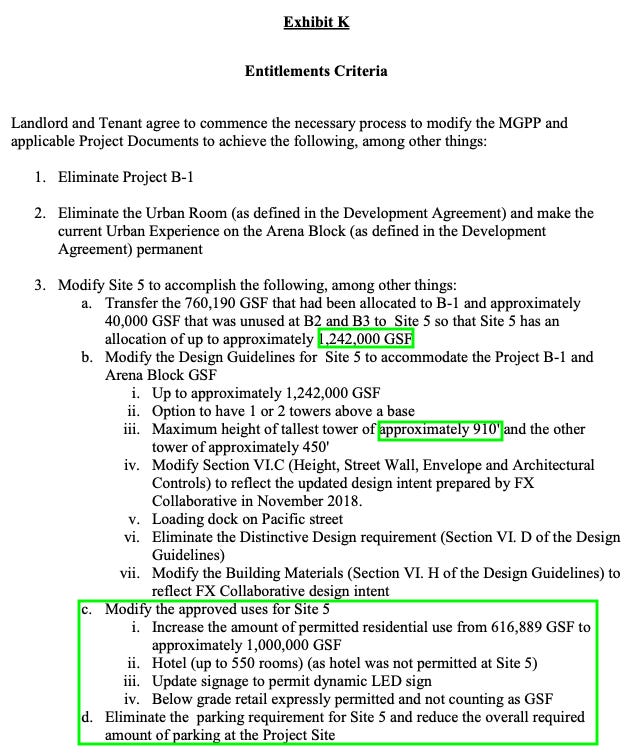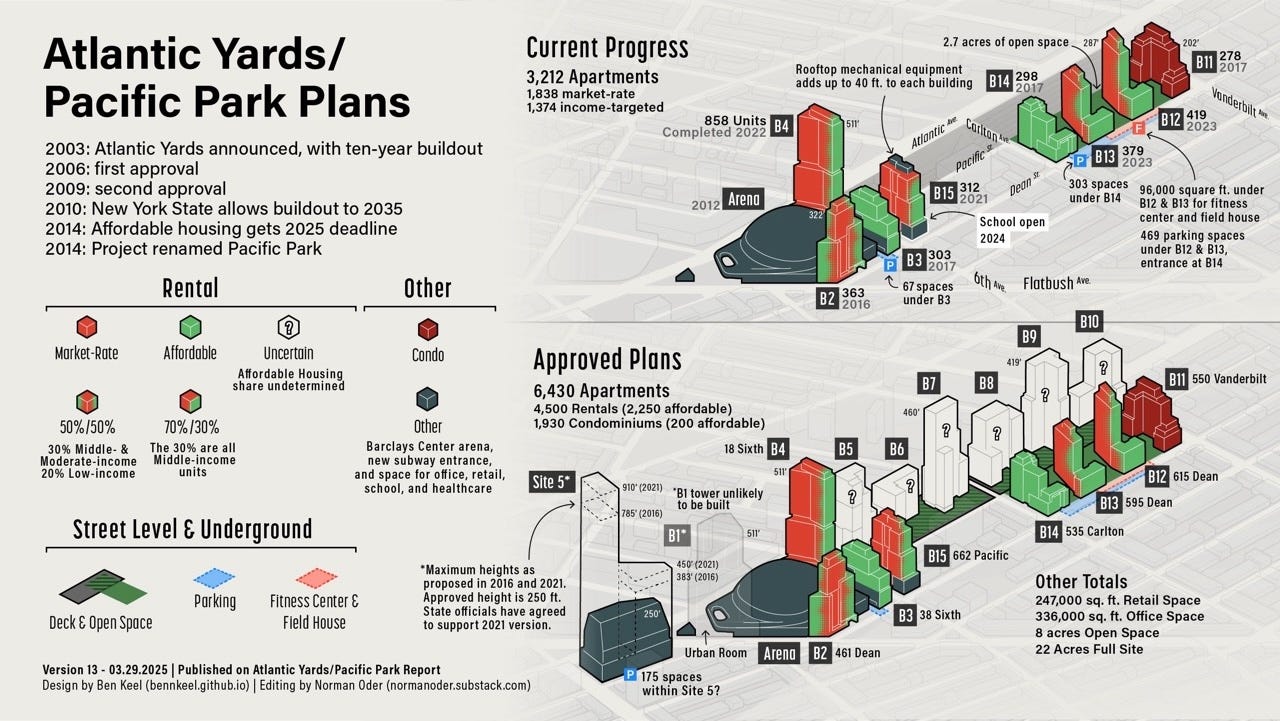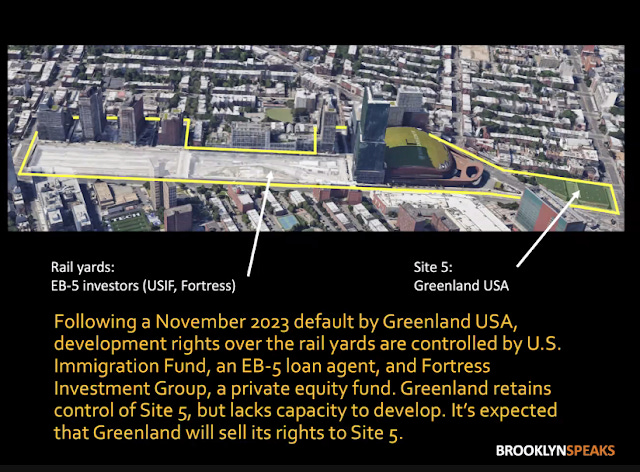Revisiting BrooklynSpeaks' 2022 Crossroads Session: A Huge Irony
Participants said the developer shouldn't get more slack without delivering on commitments. But New York State had *already* agreed on an expanded Site 5 plan.
In 2022, the coalition BrooklynSpeaks, anticipating a new phase in the project, sponsored a four-week series of charrettes called Brooklyn Crossroads, addressing urban design; transportation and streets; affordable housing; and accountability.
Looming over that final session, on accountability, was developer Greenland USA’s expected request for a lucrative project change.
Greenland was expected to seek state permission to transfer most of the bulk of the unbuilt B1 tower (aka “Miss Brooklyn”), once slated to loom over the arena, across Flatbush Avenue to create a giant two-tower project at Site 5, longtime home to P.C. Richard and the now-closed Modell’s.
That site in 2006 has been approved for a 250-foot building with 439,050 square feet. By 2016, though, developers—wary of building “Miss Brooklyn” over a working arena—floated plans for a two-tower project rising nearly 800 feet, with 1.1 million square feet of bulk.
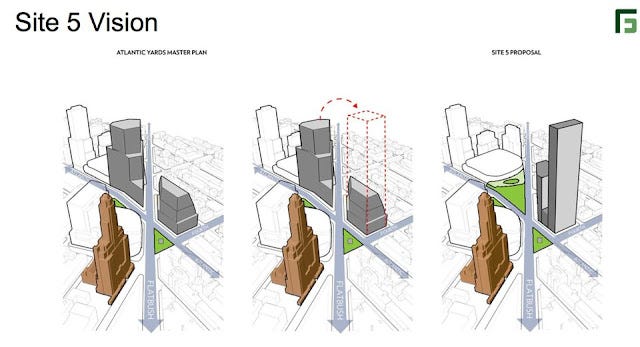
So Greenland, many people thought, was expecting New York State approval of that valuable request, even as the May 2025 deadline to deliver 2,250 affordable housing units was clearly in jeopardy.
(Since then, New York State has suspended $2,000/month penalties for the 876 unbuilt affordable units, claiming it’s waiting for a new plan.)
What’s the trade-off?
Anticipating that approval, one discussion question at Crossroads, as shown in the slide below, was: “Who should determine what additional public benefits are warranted when Atlantic Yards developers receive additional rights?”
Preparing attendees to discuss that issue, presenter Regina Cahill of the North Flatbush Business Improvement District, observed, “So that really speaks to the trade-off: Can they go up 80 stories if they give us another acre of parkland, another school?”
That tension wasn’t fully resolved. However, reporting back from a breakout discussion group, Cahill said the central message was “Don't give the developer any more until they meet the commitments they've already made.”
A secret deal, part 1
Well, guess what?
BrooklynSpeaks, along with the rest of us, was flying blind, unaware that the developer had already gotten more.
ESD had already agreed to make Site 5 even larger than as requested in 2016. It had started, in a November 2018 presentation made to ESD, promoting a 910-foot tower at Site 5 as be part of “The Brooklyn Trio,” the borough’s three largest buildings.
(The others would be The Brooklyn Tower, the borough’s first supertall, and the planned 840-foot tower at The Alloy Block, formerly known as 80 Flatbush.)
A secret deal, part 2
Then ESD, in October 2021, agreed to give the developer more at Site 5. In the 2021 Site 5 Interim Lease, ESD agreed to support an even larger project, with the taller tower rising 910' and a total of 1.242 million square feet, about 100,000 more than in the previous plan.
The Floor Area Ratio (FAR) would be 25.5, I estimated. (FAR is a common measure of bulk as a multiple of the underlying lo.) That’s astoundingly large, more than twice that of the Downtown Brooklyn rezoning and more than 50% larger than the spot rezoning for The Alloy Block.
Other developer gains
Notably, as detailed in Exhibit K below, the Site 5 deal also would allow a large, 550-room hotel (perhaps a flagship for the arena?); new valuable LED signage; a swap of below-grade parking for retail, which then would not count against the overall square footage.
We didn’t learn any of that that until last year, when both I and Gib Veconi of the Prospect Heights Neighborhood Development Council, who led the BrooklynSpeaks charettes, got the document via Freedom of Information Law requests.
Public discussion
At a meeting last August of the purportedly advisory Atlantic Yards Community Development Corporation (AY CDC), Veconi, a Director, expressed dismay about the ESD action, which implied support for a formal approval by the authority’s board.
Exhibit K, he said, "has the effect of transferring density from the arena block to Site 5, reprogramming that density from commercial to residential, removing the Urban Room from the project, making the public plaza outside of Barclays Center permanent and creating a loading dock on Pacific Street.”
Such things should require environmental review under state rules, "but these were all agreed without environmental review," he observed, suggesting that, despite that expected future public process, the developers "would probably" consider the promises binding.
Could the lease, he asked, be amended for less density or other commitments? "That document," responded ESD's Joel Kolkmann, Senior Vice President, Real Estate, "says that ESD would endeavor to move forward with a public approval process for that."
They never told us, until they had to.
Another transparency fail
At an earlier AY CDC meeting, in June 2024, Chair Daniel Kummer proposed that the Directors ask ESD to have the developer outline a residential project at Site 5.
That suggestion prompted discussion and debate among the Directors--not ESD executives--about the timing, configuration, and affordability of the potential building(s) at Site 5, as well as the value to the arena operator of making the plaza permanent.
Kummer was flying blind, as were his AY CDC colleagues, as the interim lease had not yet surfaced. ESD executives had neglected to inform the body that is supposed to “improve oversight and monitoring of the project.”
What’s next?
Given this dismaying record of transparency, it’s hard to imagine how any potential process for “community engagement”—an upcoming phase, likely after a new project developer is chosen—could work.
That new developer, likely a joint venture involving Cirrus Real Estate, might be taking over/incorporating Greenland’s development rights at B1 and Site 5,.
That joint venture, which also would assume development rights for the six towers over the MTA’s Vanderbilt Yard, might seek more bulk (free land!) to make the project more economically feasible (or lucrative), just as Greenland proposed in 2023.
If the state negotiates agreements with the developer before any public consultation, that leaves space for changes—or rethinking—only at the margins. They did it before. Why doubt they’d do it again?
An alternate view
Though he praised the 2022 BrooklynSpeaks initiative, advocacy planner Ron Shiffman said he’d urged organizers “to think a bit more aggressively about how the project should be restructured, governed, replanned, and managed."
Shiffman said he saw less a planning process from BrooklynSpeaks than a "bargaining process that accepts the existing program as is.” (Again, this was before we knew of the 2021 agreement.) “I would urge them to abandon a bargaining process and aggressively pursue the redesign of the project."
The could be triggered, he added, by significant public help for the project. Back then, he could envision federal funds from a Democratic presidential administration. Today, federal help is unlikely, though state or city help may be on the table.
“The underlying feeling I had,” said Shiffman, now a Director of the AY CDC, “is everyone feels that we have to deal with this as business as usual, so the developer delivers on the original commitments. I think the commitments have to be redrawn, with a greater role from the public sector.”
What else?
BrooklynSpeaks in 2022 asked for more deeply affordable housing; new commitments in response to quality-of-life conditions, such as residential parking permits; a system to take reports of community complaints regarding construction or operations; and establishment of a Special Enforcement District to coordinate city responses.
Most of those struck me as reasonable requests, but not necessarily if in exchange it lets the developer steer Site 5.
They updated their “asks” last year, as shown in the below link.
BrooklynSpeaks to Elected Officials: Ensure Deeply Affordable Housing, Have Arena Operator Fund Monitors
What’s the “community response” to pending changing in Atlantic Yards/Pacific Park, involving six tower sites over the Metropolitan Transportation Authority’s Vanderbilt Yard and the parcel opposite the arena known as Site 5?
Factors in the trade-off
We shouldn’t forget that, as I've written, the discount price Greenland USA paid to enter the project, taking over from Forest City Ratner, surely factored in the risk of not building "Miss Brooklyn" (or using all the square footage).
Similarly, after ESD agreed to suspend the affordable housing penalties, Veconi last month warned that those on the hook include sophisticated “investors who have been speculating in the distressed debt of the current developer…. They understood that they were taking on something that has risk and liability in the form of these liquidated damages.”
“And there is no possible justification for letting them off the hook,” he added, in a seeming refrain of “Don't give the developer any more until they meet the commitments they've already made.”
Meanwhile, the project’s biggest winner is Joe Tsai’s BSE Global, the owner of the Brooklyn Nets, New York Liberty, and arena operating company, able to monetize the arena plaza in new ways and to get lucrative new investment from the Koch family.
Maybe New York State, rather than giving away more value to the next developer, could gain value for the public from others who’ve already reaped huge profits from the project: BSE Global.


